PhysCon & Beyond
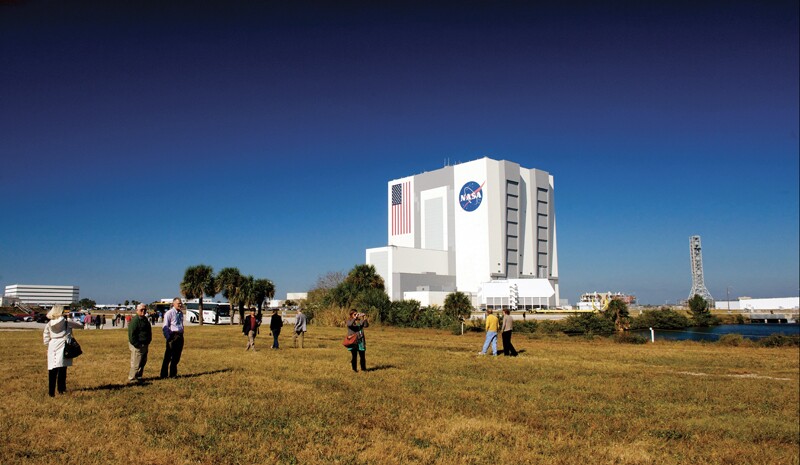
Past Sigma Pi Sigma President George Miner, University of Dayton ’78 (second from left) and David Dunlap, University of Maine ’78 (third from left) are pictured along with students, alumni, and PhysCon guests as they tour NASA Kennedy Space Center on Thursday, November 8, 2012. Photo by Michael Duncan.
For most physics majors, the Sigma Pi Sigma Congress is a once-in-an-undergraduate career opportunity. Students come to connect with kindred spirits—peers who share their fascination with uncovering the secrets of the world around us. Not everyone experiences the same rush at the practice of discovery, but the allure of learning about, and perhaps even contributing to, our knowledge of how nature unfolds from the quark to the cosmos is an irresistible hook for the not-so-common breed of humans who deem themselves physics enthusiasts. Put 800 people, mostly undergraduates, who fit this description in the same place, and you’ve got yourself a party. Add in lectures from some of the discipline’s most renowned contributors, and you better get comfortable because no one is going home early.
Physics Congresses started because Sigma Pi Sigma saw inherent value in convening its members to inform the direction of the society. And it’s true. Every four years, the deliverables from that Congress set the tone and direction for the next four years. For Sigma Pi Sigma, this has been invaluable. The individual experience, however, is perhaps the more important takeaway; the newfound energy is what keeps the honor society, and the larger Society of Physics Students, thriving.
The 2012 Quadrennial Physics Congress (dubbed PhysCon 2012) that took place November 8–10 in Orlando, FL, was the largest meeting of undergraduate physics majors in history. The diversity of attendees exceeded that of typical physics departments, with more than 30% women and nearly 20% minorities.
The Journey to Congress
“Our chapter had been eagerly anticipating the 2012 Congress because alumni, who attended the 2008 Congress, shared how exciting and unique the conference was for them,” said students from Grove City College. Long before registration opened, many schools began fundraising and putting together group travel plans. The expense of transporting large groups of students across the country was a challenge, and many chapters had to be very creative with their fundraising. “Rent-a-Student” events, “demos-for-donations,” and even bake sales helped chapters feed their Congress kitty. In an act of scientific citizenship, Abilene Christian University partnered with the Abilene Center for Contemporary Arts in an event that raised breast cancer awareness and raised funds for travel.
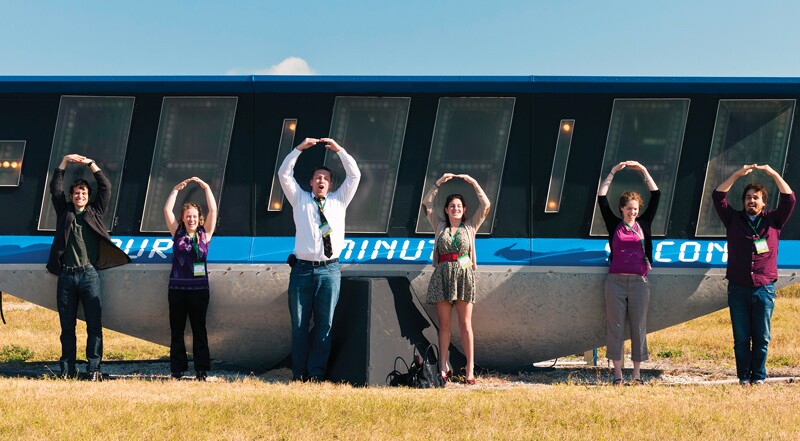
Filling in the famous countdown clock are student members of the SPS National Council and 2012 Congress Planning Committee.
Congress-goers arrived by plane, train, bus, and car, hailing from across the US, and some as far away as China. Local students also showed up in abundance, with the largest local representation from the University of Central Florida across town.
Some chapters faced pressing last-minute challenges, as Hurricane Sandy bore down on the East Coast just before the start of the meeting. Students from some schools like Richard Stockton University in New Jersey were forced to forgo travel plans, while other students from St. Peter’s College were grateful to make it: “Our flight became the last one from the airport; all the following flights were cancelled. When we left the ground, we knew we had crossed our last hurdle. We were flying to Florida.”
The Congress Experience
The opening day was much anticipated by registrants and planners alike. Eighteen dedicated NASA volunteer scientists and educators orchestrated behind-the-scenes tours at NASA’s John F. Kennedy Space Center (KSC). The opportunity to tour beyond the fence and explore such iconic structures as the launch pad and the countdown clock was a unique treat.

The KSC visitors complex sign.
Aside from the sheer novelty of being at NASA, students explored the infrastructure of the launch facilities and a select group tasked with reporting on their experience went on a VIP tour of select NASA-KSC research labs (see “NASA takes center stage,” on page 13).
“We would be lying if we said we weren’t geeking out as our bus drove up to the famous shuttle launch countdown clock by the press site, or when we got out on the crawler path leading up to the launch pad,” said students from the College of William & Mary.

The Space Shuttle Crawlerway and launch pad.
Once back at the main meeting site, the Caribe Royale Conference Center in Orlando, participants explored prospects full of possibility, as they made their way through the bustling exhibit hall. Serving as the largest networking opportunity at the Congress, the hall was filled with recruiters at 60 booths representing graduate schools, AIP member societies, and other physics-related organizations. They provided eager physics students with information on research, educational, and professional opportunities in fields such as biophysics, astrophysics, medical physics, education, optics, acoustics, high-energy physics, particle physics, and more. Several tables had games set up and were raffling prizes. Some students even got tattooed with QR codes courtesy of the SPS Jobs site. The event facilitated countless connections, with the potential to impact many lives and careers.
After nearly five hours of animated networking with exhibitors, the scene shifted to a nearby ballroom, where Sigma Pi Sigma President Dr. William DeGraffenreid officially dropped the gavel and welcomed those
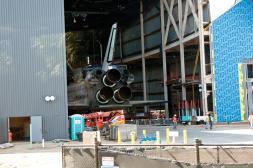
The Space Shuttle Atlantis.
assembled to the 2012 Quadrennial Physics Congress. Student members of the SPS National Council were given the distinct honor of introducing the plenary speakers. Dr. John Grunsfeld gave the opening plenary talk, and captivated the audience with personal accounts of his adventures as a “Hubble repairman,” having flown on three of the five Space Telescope servicing missions. Over the next two days, seven more plenary speakers tackled a broad range of fascinating topics, including a very well received talk titled “Reflections on the predicted end of the world in December 2012" by Jocelyn Bell Burnell (see the related story on page 15). Another standout was a talk by the legendary Freeman Dyson, titled “Living through four Revolutions.” Dyson both delighted and surprised the audience with his candid views on science education during the Q&A session following his speech. A thorough examination of his remarks will be featured in a future issue of Radiations, along with ruminations on many of the other plenary talks.

Members of the Southeast University SPS chapter (Nanjing, China) in the rocket garden.
Early Friday morning, conference-goers kicked off their day with a true “breakfast of champions” during the popular “Breakfast with the Scientists” event. More than 70 physical scientists and engineers, including 42 guests from NASA Kennedy Space Center, shared a meal and interacted with conference attendees. Several members of the American Institute of Physics Governing Board also participated in the breakfast and stayed on to experience the remainder of the Congress. Following the event, Michael Duncan, Research Physicist at the Naval Research Laboratory and Chair of the Board of Editors at OSA, The Optical Society, remarked, “it was really great interacting with the students at the Congress. The energy level was high and the excitement was palpable. I had a number of stimulating conversations with students that left me feeling very good about the future of physics.”

Kate P. Kirby, Executive Officer of The American Physical Society
Sigma Pi Sigma and the Society of Physics Students have long maintained that undergraduate research is an essential element of the physics degree. Though not required in all academic programs, Sigma Pi Sigma and SPS content that it should be. Such formative experiences as internships, REUs, or on-campus research assistantships provide students with a sense of what it means to practice science, and can even guide students to focus their graduate education on a subfield that interests them. The Congress afforded attendees the opportunity to share the results of their research or outreach projects in two contributed poster sessions. And the work presented by the nearly 200 students was not trivial, with research topics ranging from the modeling of pirate detection to advances in nanotechnology. Posters on outreach and service ranged from innovative public outreach activities to Astrobites, an online astronomy research “Readers Digest” for undergraduates written by volunteers. Abstracts for all of the posters are listed in the program, viewable at
Continuing a tradition started at Fermilab in 2008, Sigma Pi Sigma sponsored its second Congress art contest in Orlando. Within several categories related to the conference theme “Connecting Worlds,” attendees showcased their artistic flair in the form of paintings, drawings, photographs, and even several three-dimensional works of art. A panel of artists and judges selected category winners, and all conference-goers were invited to vote on the “People’s Choice” award. The American Association of Physics Teachers graciously sponsored prizes for the award-winning pieces, which are showcased on pages 24-25. Serendipitous timing permitted several PhysCon attendees from the nearby University of Central Florida (UCF) to include works of art from their school’s STEAM exhibition at the Congress—there is an in-depth look at this collaborative project between the humanities and sciences at UCF beginning on page 26.
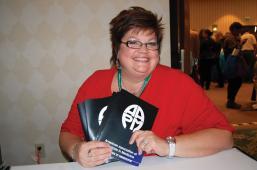
Angela R. Keyser, Executive Director of the American Association of Physicists in Medicine
The quadrennial congresses of Sigma Pi Sigma have evolved into superb forums to address a wide range of additional professional development topics for students and practicing physicists alike, primarily through thought-provoking, interactive workshops. Beyond the plenary sessions and contributed poster sessions, PhysCon 2012 offered attendees six engaging, interactive workshops. Each workshop was thoughtfully developed with broad ranging, relevant and timely topics, with the goal of providing a uniformly enriching experience for each attendee. These collaborative sessions provided participants with practical and compelling training, group discussions, and hands-on-activities that extended beyond the typical undergraduate curriculum.
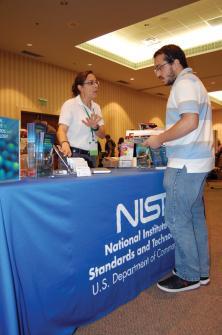
Donna Kimball, National Institute of Standards and Technology
The “Connecting Scientists and Science Policy” workshop, for example, highlighted the ongoing need for more advisory roles from real scientists to influence Congressional decisions on science policy. In what proved to be a difficult exercise, participants emulated Congressional committees by scrutinizing a set of actual science projects, and then allocating an overall 8% budget cut based on the U.S. Budget Control Act of 2011. “I now have a lot more respect for the hard decisions about what gets funded and what doesn’t,” said SPS member Maria Rusert, of Georgia State University. On a similar note, all PhysCon attendees were provided with an online form provided by The American Physical Society that helped them write to their Congressional representatives and express their thoughts on the importance of federal science policy.

Sigma Pi Sigma president Bill Degraffenreid calls a packed ballroom to order as he opens the Congress.
During the “Connecting Academia and Industry” workshop, registrants brainstormed about products and services that could do well in the marketplace, learning how to bridge from basic research to the commercial world. In the parallel session “Connecting Diverse Perspectives in Science,” facilitators seeded conversations and identified actions that could effectively advance the diversity of the physics community. In other sessions, participants completed self-assements of physics-related skills and discussed how they apply to entering the workforce, and conducted a group experiment to investigate the probable outcome of rolling non-cubic die in an exploration of science outreach.
New to the Congress lineup in 2012 was a Friday-night dance party dubbed “Club Congress,” sponsored by The American Physical Society. With a live DJ taking song requests and a theatrical liquid nitrogen ice cream vendor creating delicious refreshments in real-time, hundreds of high-spirited physics students transformed the center of a staid ballroom into a thumping and jiving dance floor, which was packed to capacity all night. This less-formal party atmosphere provided a space for newly made friends and Sigma Pi Sigma alumni to get to know each other better, reminisce on their school days and recent adventures, and celebrate their time together.
But the most impactful aspects of PhysCon could not be planned or organized. In the words of the student attendees:
“As a whole, the Congress was compelling for one simple reason: it reminded and reinforced our drive to join a professional scientific community.” -students from the College of Wooster.
“Having the opportunity to talk with the physicists invited to give talks was amazing, but simply talking to physics students from around the country helped to open our eyes to the larger physics community.” -students from Idaho State University
“For us, attending the conference was like meeting a long-lost family. The love, support, and friends that we made during the conference will stay with us forever.” -students from St. Peter’s College. //



